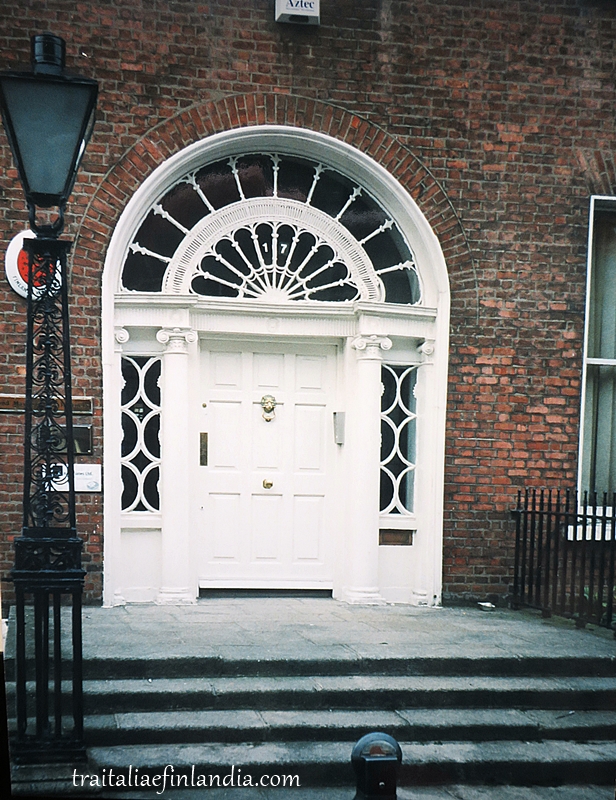(Please scroll down for English text)
Certamente voi tutti avete sentito parlare di quello stile architettonico molto particolare e tipico della Gran Bretagna denominato: stile Georgiano. Il nome si rifà al periodo storico che va dal 1714 al 1830 in cui nel Paese regnarono da re Giorgio I a Giorgio IV. Durante questi decenni in Gran Bretagna si attuarono una serie di riforme sociali: dall’abolizione della schiavitù alla costituzione di servizi sociali importanti come gli orfanotrofi, alla Rivoluzione industriale; non ultima della serie fu la pianificazione razionalizzata dell’espansione dei nuclei urbani.
Dal punto di vista squisitamente architettonico, lo stile del periodo si concretizza in una reazione al barocco, ormai sorpassato e nell’avvicinamento allo stile palladiano: razionale, simmetrico, pulito, di ispirzione neoclassica. Prendendo in esame solamente le porte degli edifici, soggetto di questo post, anch’esse furono costruite seguendo criteri precisi che puntano ad esaltarne l’armonia, il colore, creando uno stile molto particolare che sopravvisse alle mode del momento.
Come vedete nelle mie foto le “Georgian doors”, le porte in stile georgiano di Dublino meritano un post a se’ stante, tanto sono belle ed appariscenti.
Alcune loro caratteristiche fondamentali: generalmente sono pannelli lignei senza vetrate, solo nella parte superiore possono avere una lunetta da dove entra la luce; devono avere una rientranza rispetto al muro dell’edificio di almeno una ventina di cm; sono quasi sempre abbellite da pilastri, frontoni, ringhiere, scalini, capitelli.

In questa foto: il consolato finlandese a Dublino, come lo abbiamo visto noi nel 1997.
Doors of Dublin.
Hello dear readers! You all certainly know about the unique and exquisitely British architectural style named: Georgian style. Its definition dates back to the years between 1714 and 1830, encompassing the reigns of king George I to George IV. During these decades Britain went through a considerable social change and many reforms were made: from the Slavery abolition Act to the Industrial revolution, to the creation of important social structures like orphanages; last but not least, the rational planning of urban development.
As far as architecture is concerned, the style of the times was essentially a reaction against Baroque, already at its end, and a turning to a purer, more balanced and rational style inspired by Neo-classicism, filtered by the example of architect Andrea Palladio.
The subject of this post are the doors of the buildings: they were also built following precise rules which would bring out their harmony and colours, creating a unique style which survived until nowadays.
As you can see in my shots, the so-called “Georgian Doors” deserve a post for themselves: they are in fact beautiful and stylish.
Here are a few essential features: Georgian Doors are generally built as panelled wood without glass, just a semi-circular fanlight is inserted above. They are set back at least twenty centimeters from the brick gable and are often decorated with pillars, rails, pediments, porches and capitals.
In my parting shot: the Finnish consulate in Dublin, as we saw it in 1997.
****
.
Linked to: WATW. My Corner of the World. All Seasons.

That is a really magnificent door
"Mi piace"Piace a 2 people
Thank you very much, Sheree. Have a nice day!
"Mi piace"Piace a 2 people
Molto particolari! Buona settimana cara!
"Mi piace"Piace a 2 people
Davvero. Grazie, cara, anche a te! Buon lavoro!
"Mi piace"Piace a 2 people
Hello,
The last door is really beautiful! Great collection of doors and photos! Take care, have a great day and a happy new week!
"Mi piace"Piace a 2 people
Gostei destas magnificas portas.
Um abraço e boa semana.
Andarilhar
Dedais de Francisco e Idalisa
Livros-Autografados
"Mi piace"Piace a 2 people
Dublino è bellissima, visitata in 5 giorni 2 anni fa.
Non mi sono soffermato sulle porte…ma ho assaggiato molte birre.
"Mi piace"Piace a 2 people
…I love architecture and particularly doors. Luisella, you have captured some beautiful ones, thank you!
"Mi piace"Piace a 2 people
Quelle anche noi! :-):-):-)
"Mi piace"Piace a 2 people
Thank you, Eileen. Glad you like my shots. Have a great week you too!
"Mi piace"Piace a 2 people
Thank you, Tom, for your kind comment. Have a great week!
"Mi piace"Piace a 1 persona
Innamorarsi già all’ingresso 🙂
"Mi piace"Piace a 2 people
You too
"Mi piace"Piace a 2 people
Si, davvero. 🙂
"Mi piace"Piace a 2 people
Thank you very much. Boa semana!
"Mi piace"Piace a 1 persona
interessante questa riflessione sull’architettura….😉 buona serata, un caro abbraccio…🤗
"Mi piace"Piace a 2 people
Grazie mille! Buona serata. 🙂
"Mi piace"Piace a 2 people
queste porte sono veramente belle…oserei dire un’opera d’arte!
Ciao, buona serata.
"Mi piace"Piace a 2 people
Beautiful architecture!
"Mi piace"Piace a 2 people
How lovely to see these windows and doors.
It is such nice architecture.
All the best Jan
"Mi piace"Piace a 2 people
Thank you, Jan. All the best!
"Mi piace"Piace a 1 persona
Thanks. It is, indeed. Good Day to you!
"Mi piace"Piace a 1 persona
Si, anche io le trovo stilose e raffinate. Buona giornata e grazie.
"Mi piace"Piace a 1 persona
These door are really elegant and classy. It’s a shame that pride of these buildings faded with the rest of the world. Love these photos so much!
Thank you for being a part of ‘My Corner of the World’ this week!
"Mi piace"Piace a 1 persona
Thank you for hosting. Happy weekend!
"Mi piace""Mi piace"
You spotted some beautiful examples!
"Mi piace"Piace a 1 persona
I love the Georgian doors – impressive.
"Mi piace"Piace a 1 persona
Thank you Lisal
"Mi piace""Mi piace"
Thank you, Carol. So they are. 🙂
"Mi piace""Mi piace"
Have to admit I don’t know much about the history of England (except for Victorian). After I read your text, my question how come you know so much about Georgian doors was answered at the end where you told you were there:) Beautiful doors! Have to admit, I never like the Baroque art – too busy and too many curls present in the designs! In the Netherlands art came to a high point after the Baroque with Rembrandt and van Gogh. Many thanks for showing All Seasons these architectural beauties of the post-Baoque period, Have a beautiful week, Jesh
"Mi piace"Piace a 1 persona
THank you very much for your appreciation. Have a great week!
"Mi piace""Mi piace"